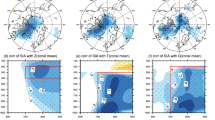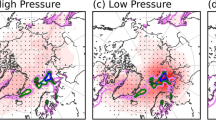Abstract
The recent decline in the Arctic sea ice has coincided with more cold winters in Eurasia. It has been hypothesized that the Arctic sea ice loss is causing more mid-latitude cold extremes and cold winters, yet there is lack of consensus in modeling studies on the impact of Arctic sea ice loss. Here we conducted modeling experiments with Community Atmosphere Model Version 5 (CAM5) to investigate the sensitivity and linearity of Eurasian winter temperature response to the Atlantic sector and Pacific sector of the Arctic sea ice loss. Our experiments indicate that the Arctic sea ice reduction can significantly affect the atmospheric circulation by strengthening the Siberian High, exciting the stationary Rossby wave train, and weakening the polar jet stream, which in turn induce the cooling in Eurasia. The temperature decreases by more than 1°C in response to the ice loss in the Atlantic sector and the cooling is less and more shifts southward in response to the ice loss in the Pacific sector. More interestingly, sea ice loss in the Atlantic and Pacific sectors together barely induces cold temperatures in Eurasia, suggesting the nonlinearity of the atmospheric response to the Arctic sea ice loss.
Similar content being viewed by others
References
Archer C L, Caldeira K. 2008. Historical trends in the jet streams. Geophys Res Lett, 35(8): L08803
Barnes E A, Screen J A. 2015. The impact of Arctic warming on the midlatitude jet-stream: can it? has it? will it?. WIREs Climate Change, 6(3): 277–286
Curry J A, Schramm J L, Ebert E. 1995. Sea ice-albedo climate feedback mechanism. J Climate, 8(2): 240–247
Deser C, Tomas R A, Peng Shiling. 2007. The transient atmospheric circulation response to North Atlantic SST and sea ice anomalies. J Climate, 20(18): 4751–4767
Francis J A, Chan Weihan, Leathers D J, et al. 2009. Winter Northern Hemisphere weather patterns remember summer Arctic seaice extent. Geophys Res Lett, 36(7): L07503
Francis J A, Vavrus S J. 2012. Evidence linking Arctic amplification to extreme weather in mid-latitudes. Geophys Res Lett, 39(6): L06801
Francis J A, Vavrus S J. 2015. Evidence for a wavier jet stream in response to rapid Arctic warming. Environ Res Lett, 10(1): 014005
Gerber F, Sedláček J, Knutti R. 2014. Influence of the western North Atlantic and the Barents Sea on European winter climate. Geophys Res Lett, 41(2): 561–567
Honda M, Yamazaki K, Nakamura H, et al. 1999. Dynamic and thermodynamic characteristics of atmospheric response to anomalous sea-ice extent in the Sea of Okhotsk. J Climate, 12(12): 3347–3358
Honda M, Inoue J, Yamane S. 2009. Influence of low Arctic sea-ice minima on anomalously cold Eurasian winters. Geophys Res Lett, 36(8): L08707
Jaiser R, Dethloff K, Handorf D, et al. 2012. Impact of sea ice cover changes on the Northern Hemisphere atmospheric winter circulation. Tellus A, 64(1): 11595
Kug J S, Jeong J H, Jang Y S, et al. 2015. Two distinct influences of Arctic warming on cold winters over North America and East Asia. Nat Geosci, 8(10): 759–762
Li Chao, Stevens B, Marotzke J. 2015. Eurasian winter cooling in the warming hiatus of 1998–2012. Geophys Res Lett, 42(19): 8131–8139
Liu Jiping, Curry J A, Wang Huijun, et al. 2012a. Impact of declining Arctic sea ice on winter snowfall. Proc Natl Acad Sci U S A, 109(11): 4074–4079
Liu Na, Liu Jiping, Zhang Zhanhai, et al. 2012b. Is extreme Arctic sea ice anomaly in 2007 a key contributor to severe January 2008 snowstorm in China?. Int J Climatol, 32(13): 2081–2087
Manabe S, Stouffer R J. 1980. Sensitivity of a global climate model to an increase of CO2 concentration in the atmosphere. J Geophys Res, 85(10): 5529–5554
McCusker K E, Fyfe J C, Sigmond M. 2016. Twenty-five winters of unexpected Eurasian cooling unlikely due to Arctic sea-ice loss. Nat Geosci, 9(11): 838–842
Neale R B, Richter J H, Conley A J, et al. 2011. Description of the NCAR community atmosphere Model(CAM5). Technical Report NCAR/TN-486+STR. Boulder, Colorado: National Center for Atmospheric Research, 268
Overland J E, Wang Muyin. 2010. Large-scale atmospheric circulation changes are associated with the recent loss of Arctic sea ice. Tellus A, 62(1): 1–9
Overland J E, Wood K R, Wang Muyin. 2011. Warm Arctic-cold continents: climate impacts of the newly open arctic sea. Polar Res, 30(1): 15787
Overland J E. 2016. Is the melting Arctic changing midlatitude weather?. Phys Today, 69(3): 38–43
Peings Y, Magnusdottir G. 2014. Response of the wintertime Northern Hemisphere atmospheric circulation to current and projected Arctic sea ice decline: a numerical study with CAM5. J Climate, 27(1): 244–264
Perlwitz J, Hoerling M, Dole R. 2015. Arctic tropospheric warming: causes and linkages to lower latitudes. J Climate, 28(6): 2154–2167
Petoukhov V, Semenov V A. 2010. A link between reduced Barents-Kara sea ice and cold winter extremes over northern continents. J Geophys Res, 115(D21): D21111
Screen J A, Simmonds I. 2010. The central role of diminishing sea ice in recent Arctic temperature amplification. Nature, 464(7293): 1334–1337
Screen J A, Simmonds I, Deser C, et al. 2013. The atmospheric response to three decades of observed arctic Sea Ice loss. J Climate, 26(4): 1230–1248
Screen J A, Deser C, Simmonds I, et al. 2014. Atmospheric impacts of Arctic sea-ice loss, 1979-2009: separating forced change from atmospheric internal variability. Climate Dyn, 43(1–2): 333–344
Screen J A, Francis J A. 2016. Contribution of sea-ice loss to Arctic amplification is regulated by Pacific Ocean decadal variability. Nat Climate Change, 6(9): 856–860
Serreze M C, Barrett A P, Stroeve J C, et al. 2009. The emergence of surface-based Arctic amplification. Cryosphere, 3(1): 11–19
Serreze M C, Barry R G. 2011. Processes and impacts of Arctic amplification: a research synthesis. Glob Planet Change, 77(1–2): 85–96
Stroeve J, Holland M, Meier W, et al. 2007. Arctic sea ice decline: faster than forecast. Geophys Res Lett, 34(9): L09501
Stroeve J C, Serreze M C, Holland M, et al. 2012. The Arctic’s rapidly shrinking sea ice cover: a research synthesis. Climatic Change, 110(3–4): 1005–1027
Sui Cuijuan, Zhang Zhanhai, Wu Huiding, et al. 2015. Interannual and interdecadal variability of arctic sea ice extent from 1979–2012. Chin J Polar Res (in Chinese), 27(2): 174–182
Sun Lantao, Perlwitz J, Hoerling M. 2016. What caused the recent “Warm Arctic, Cold Continents” trend pattern in winter temperatures?. Geophys Res Lett, 43(10): 5345–5352
Tang Qiuhong, Zhang Xuejun, Yang Xiaohua, et al. 2013. Cold winter extremes in northern continents linked to Arctic sea ice loss. Environ Res Lett, 8(1): 014036
Vihma T. 2014. Effects of Arctic sea ice decline on weather and climate: a review. Surv Geophys, 35(5): 1175–1214
Wu Bingyi, Huang Ronghui, Gao Dengyi. 1999. Effects of variation of winter sea-ice area in Kara and Barents seas on East Asia winter monsoon. Acta Meteor Sinica, 13(2): 141–153
Wu Bingyi, Su Jingzhi, D’Arrigo R. 2015. Patterns of Asian winter climate variability and links to Arctic sea ice. J Climate, 28(17): 6841–6858
Acknowledgements
The authors are grateful to Sun Lantao for the discussion, and three anonymous reviewers for the valuable suggestions and comments.
Author information
Authors and Affiliations
Corresponding author
Additional information
Foundation item: The Chinese Polar Environment Comprehensive Investigation and Evaluation Programmes under contract No. CHINARE2016-04-04; the Public Science and Technology Research Funds Projects of Ocean under contract No. 201505013; the National Natural Science Foundation of China (NSFC) under contract No. 41576029.
Rights and permissions
About this article
Cite this article
Sui, C., Zhang, Z., Yu, L. et al. Sensitivity and nonlinearity of Eurasian winter temperature response to recent Arctic sea ice loss. Acta Oceanol. Sin. 36, 52–58 (2017). https://doi.org/10.1007/s13131-017-1018-y
Received:
Accepted:
Published:
Issue Date:
DOI: https://doi.org/10.1007/s13131-017-1018-y




